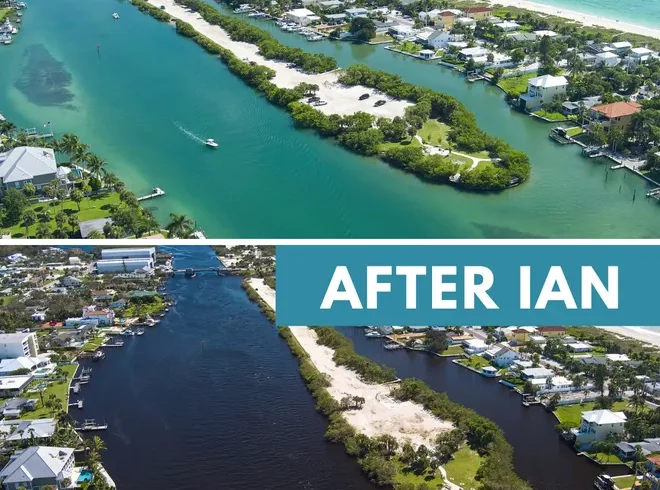Manatee County rakes 7,000 pounds of dead fish in two weeks
Currently, there is roughly 100 square miles of Florida’s Gulf Coast waters are painted with red tide. The harmful algal bloom, , is now strongest around Venice inlet, but spans from the northern end of Longboat Key all the way down to Boca Grande, according to a satellite analysis done by Dr. Dave Tomasko, executive director of the Sarasota Bay Estuary Program.
According to Tomasko, this red tide is a continuation of the bloom that has been with us since after Hurricane Ian flushed untold amounts of nutrients into Sarasota and Tampa Bay. “After Ian, lower Sarasota Bay was in pretty bad shape for about 2-4 weeks, then it got better,” says Tomasko. “But how did it get better? By moving that load of stormwater runoff into the Gulf of Mexico.”
“2018’s red tide followed 2017’s Hurricane Irma. In 2022, we had Hurricane Ian. What we are a little bit concerned about is will 2023 turn out like 2018 in terms of red tide,” asked Dr. David Tomasko, director of Sarasota Bay Estuary Program.
“It’s probably not a really good time to be recreating on the bay, there is bacteria out there that can get you pretty sick,” Tomasko said. “When the water looks kind of like root beer, don’t go in it.”
“You want to reduce red tide? Then get ahold of the nutrient loads and make them less than they are right now,” “We need legislative support at all levels for doing a better job with our wastewater and stormwater infrastructure, that’s number one,” “We want money to be available, we want more research into mitigation. Our infrastructure is aging and our population increasing this is part of the problem that we’ve got,” Dr. David Tomasko said.
“There is very high levels of bacteria coming into our bays along with these floodwaters. That’s because of the kind of underwater compost heap, dead animals, sewage, dog poop, grass clippings, all this stuff coming into the bays,” he said. “Literally, we found plumes of brackish, tannin-rich water two miles offshore.”
A 5,000-mile-long sheet of seaweed in the Atlantic Ocean threatens to stink up our beaches along the Gulf of Mexico. “We’ve known about this for a little while,” says Dave Tomasko, executive director of the Sarasota Bay Estuary Program. “There have been bad sargassum blooms in the past, but this is the biggest one we’ve ever seen, and it’s got a lot of people worried.”
Seagrass dies:
Every two years, the region’s water management agency creates maps of seagrass meadows in an area from Tarpon Springs to Boca Grande, Tomasko said. Sarasota Bay’s seagrass coverage decreased by 26% from 2016 to 2022, and Tampa Bay’s went down by 28%, Tomasko said.The most recent mapping took place from December 2021 to February 2022. The mapping results, which were released last month, show that there was a 5% decline in Sarasota Bay’s seagrass acreage from 2020 to 2022. During the previous two-year period – 2018 to 2020 – the acreage dropped by 18%, or about 2,000 acres, according to Tomasko.
A local organization is filing a petition with the U.S. Fish and wildlife Service to change the status of manatees to endangered.
Manatees were removed from the endangered list back in 2017, and since then have seen some huge losses of life.
“It’s incredibly heartbreaking to see this iconic species just whither away, whither to death for the lack of seagrass forage and food,” said Eagan Whitlock with the Center for Biological Diversity
Whitlock is talking about manatees.
“Over the last two years, we’ve been under an unusual mortality event. We’ve lost nearly 2,000 manatees in 2021 and 2022 combined,” said Whitlock.
Dr. Dave Tomasko with the Sarasota Bay Estuary Program says a big reason for the manatee deaths is unpredicted environmental events.
“Our problems are related to humans making red tide worse. Think of Tampa Bay in 2021 when you had Piney Point and you had in the middle and upper part of Tampa Bay the worst red tide in 50 years,” said Dr. Tomasko.
Dr. Tomasko says the Piney Point incident, in which millions of gallons of contaminated water leaked into the Gulf of Mexico, pollution, heavy rain, and the use of fertilizer has caused sea grass to start disappearing.
“Over the last decade we’ve lost 150 square miles of seagrass in the state of Florida,” said Dr. Tomasko.
Now the Center for Biological Diversity filed a petition with the U.S. Fish and Wildlife Service to upgrade manatees to endangered, and the organization expects to hear back this week.
“It would invoke new funding opportunities to protect water quality and sea grasses. It would allow more full time employees at the agencies to be dedicated to manatee recovery efforts on a daily basis,” said Whitlock.
Dr. Tomasko says something needs to change soon.
“The manatees are telling us theres something going on. Theres something wrong with your water and it’s happening state wide,” said Dr. Tomasko.
CBS News
Remediation;
A Jet Ski-like device could be deployed to a patch of red tide.Water could be pumped through the system and injected under high pressure with ozone, killing red tide cells and toxins.
“Something like a Jet Ski that can produce 1,000 or 2,000 gallons per minute, if we can ozonate the seawater as quickly as it comes out of the back, then we would have the ability to produce something that could reduce red tide at a scale that is suddenly management relevant,” Dr. Tomasko explained.













